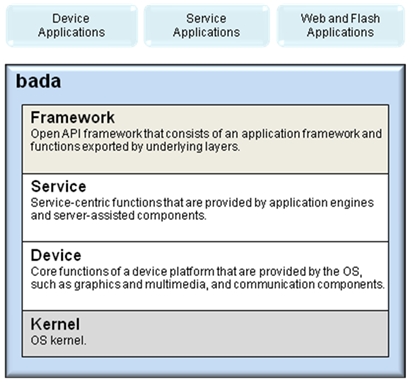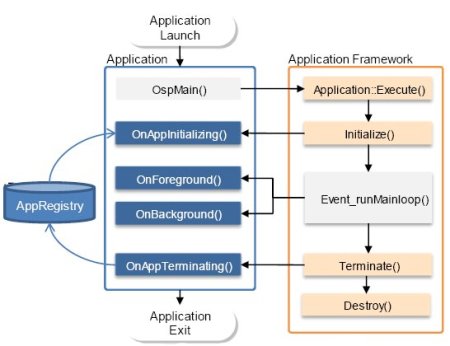Samsung’s mobile OS SDK ships, runs on Linux
Dec 8, 2009 — by Eric Brown — from the LinuxDevices Archive — viewsSamsung Electronics announced the availability of an SDK for its “Bada” mobile operating system. The kernel-configurable Bada platform can be based on a Linux kernel or another real-time OS (RTOS), and it incorporates an Eclipse-based IDE, a GNU tool-chain, and a service-centric UI framework based on Samsung's TouchWiz UI.
Samsung announced Bada in early November, without offering many details on the technology, or even making it clear whether it was based on Linux. The answer to the latter question is yes and no, as Bada's kernel-configurable architecture enables the use of either a Linux kernel or another RTOS kernel, says the company. Most likely, Linux will be the main choice for smartphones, with some feature phones instead adopting the smaller footprint of an RTOS.
 |
Named after the Korean word for "ocean," Bada appears to be destined only for Samsung-built phones. In this way, it is somewhat akin to Palm's Linux-based WebOS, which offers an open API to encourage third-party developers, but runs only on Palm-made devices.
Bada is based on a next-generation version of Samsung's cross-platform TouchWiz UI, which is available on Samsung smartphones on various platforms, including its Android-based Behold II phone (pictured). Bada also embeds Adobe Flash and the open source WebKit browser directly into native Bada applications. 
The Bada platform offers a map control that can be embedded in applications to offer interactive mapping and routing with POI features (pictured at left), says Samsung. Additional UI features include flash control, web control, motion sensing, fine-tuned vibration control, and face detection, says the company.
In addition, Bada is said to leverage a phone's accelerometers, as well as tilt, weather, proximity, and activity sensors, in order to provide contextual feedback for applications.
At the official unveiling of Bada in London, which one reporter called a jargon-filled "waste of time," Samsung was said to have promoted Bada as a mobile gaming platform. The event featured testimonials from partners including game publishers CAPCOM, EA Mobile, and Gameloft, as well as Twitter and Blockbuster.
As with other mobile UI layers like the MotoBlur service offered on Motorola phones such as the Android-based Cliq, or Vodafone's "360" service offered on the Samsung manufactured LiMo (Linux Mobile) based H1 and M1 phones, Bada provides service-centric features supported by back-end servers. These are said to include social networking integration, device synchronization, content management, location-based services, and commerce services.
Bada-based social networking applications can manage user profiles, including buddy information for application users, as well as integrate most popular social networking services, says Samsung. Device synchronization applications, meanwhile, can take advantage of PIM and contacts synchronization between Bada devices and servers, says the company. Content management applications can store and search contents on devices and servers, and location-aware applications are able to use service-provided landmark stores, maps, and geo-coding services, says the company.

Messaging dynamics between Bada client and servers
(Click to enlarge)
Bada's TouchWiz-based UI examples
(Click to enlarge)

Bada architecture
Samsung also offered more details on its previously announced Bada Developer Challenge, stating that it will hand out prizes to the most innovative Bada applications totaling a whopping $2,700,000. As was previously announced, Samsung will announce a series of Developer Days to be held in Seoul, London, San Francisco, and elsewhere, and the first phones running Bada should be available by the second quarter of 2010.

Application lifecycles in Bada
(Click to enlarge)
Stated Dr. Hosoo Lee, Executive VP and Head of the Media Solution Center at Samsung Electronics, "Samsung Bada presents a powerful opportunity for developers to get their applications onto an unprecedented number of Samsung devices across the world."
Availability
The Samsung Bada API Framework reference, SDK, and IDE are available for free download now. More information may be found at the Bada developer website, here, and more technical information may be found here. The download page for the SDK and IDE may be found here.
For a discussion of Samsung's strategy for Bada, as well as background on Samsung's Android- and LiMo-based phones, please see our previous coverage, here.
This article was originally published on LinuxDevices.com and has been donated to the open source community by QuinStreet Inc. Please visit LinuxToday.com for up-to-date news and articles about Linux and open source.
